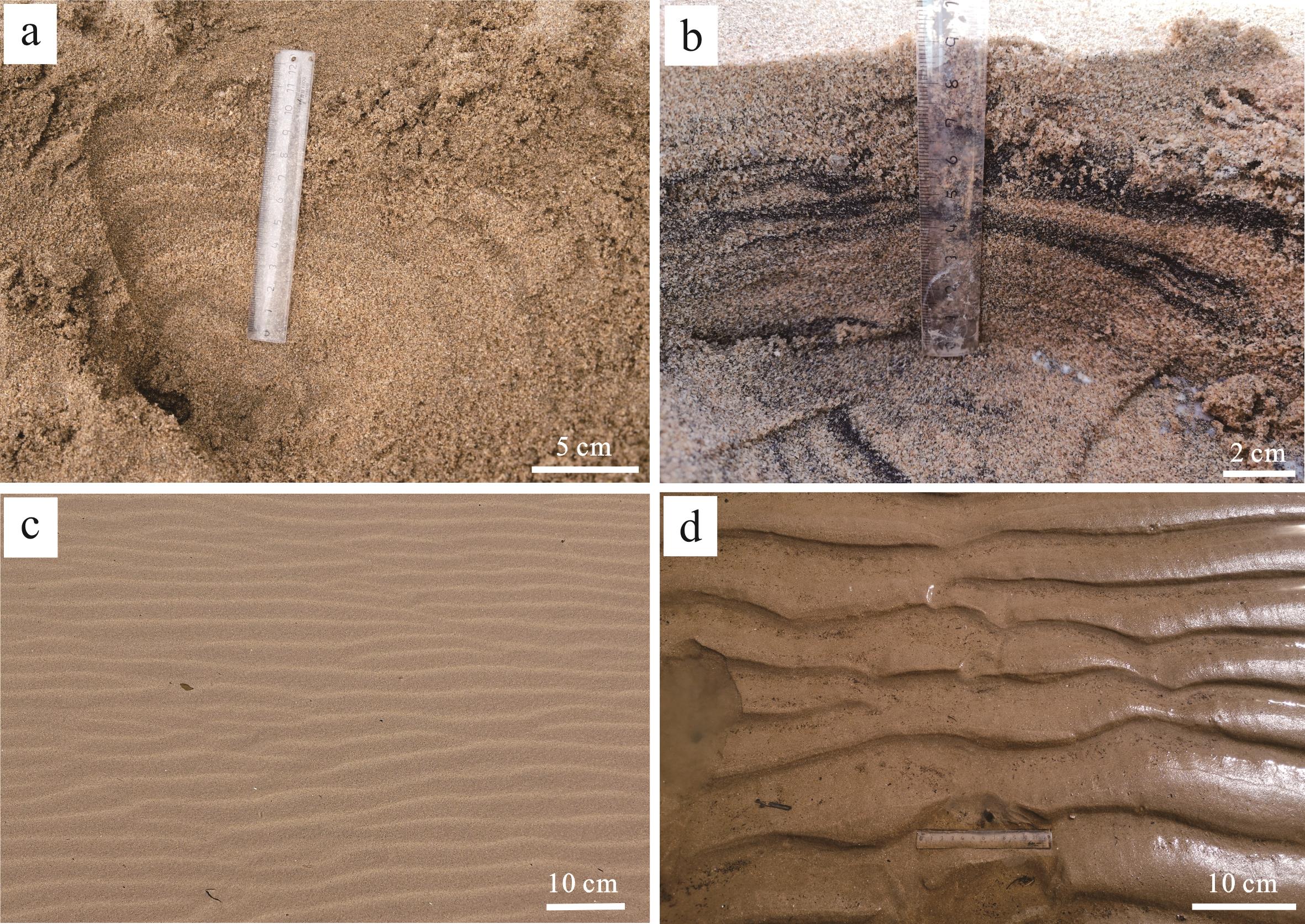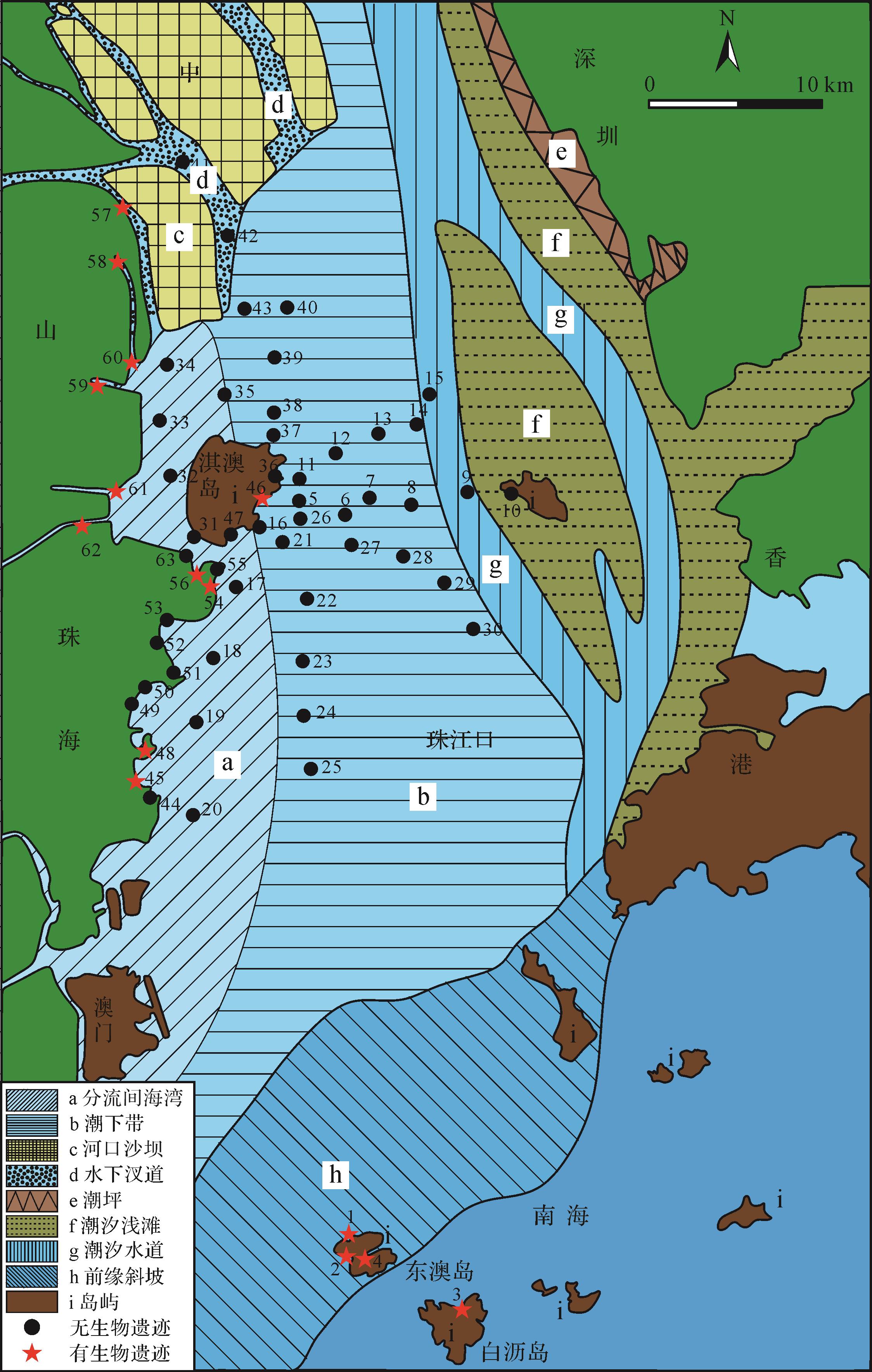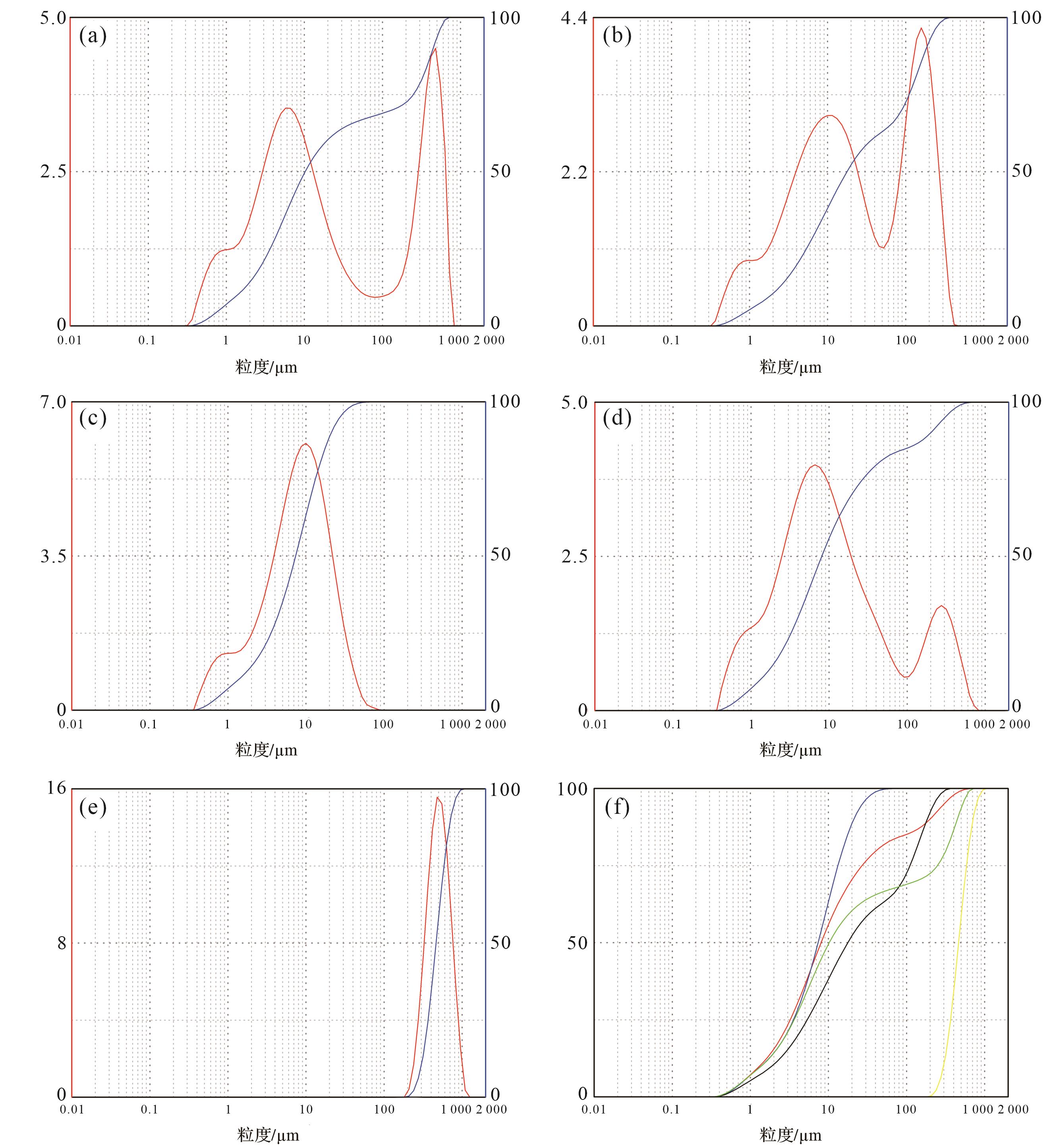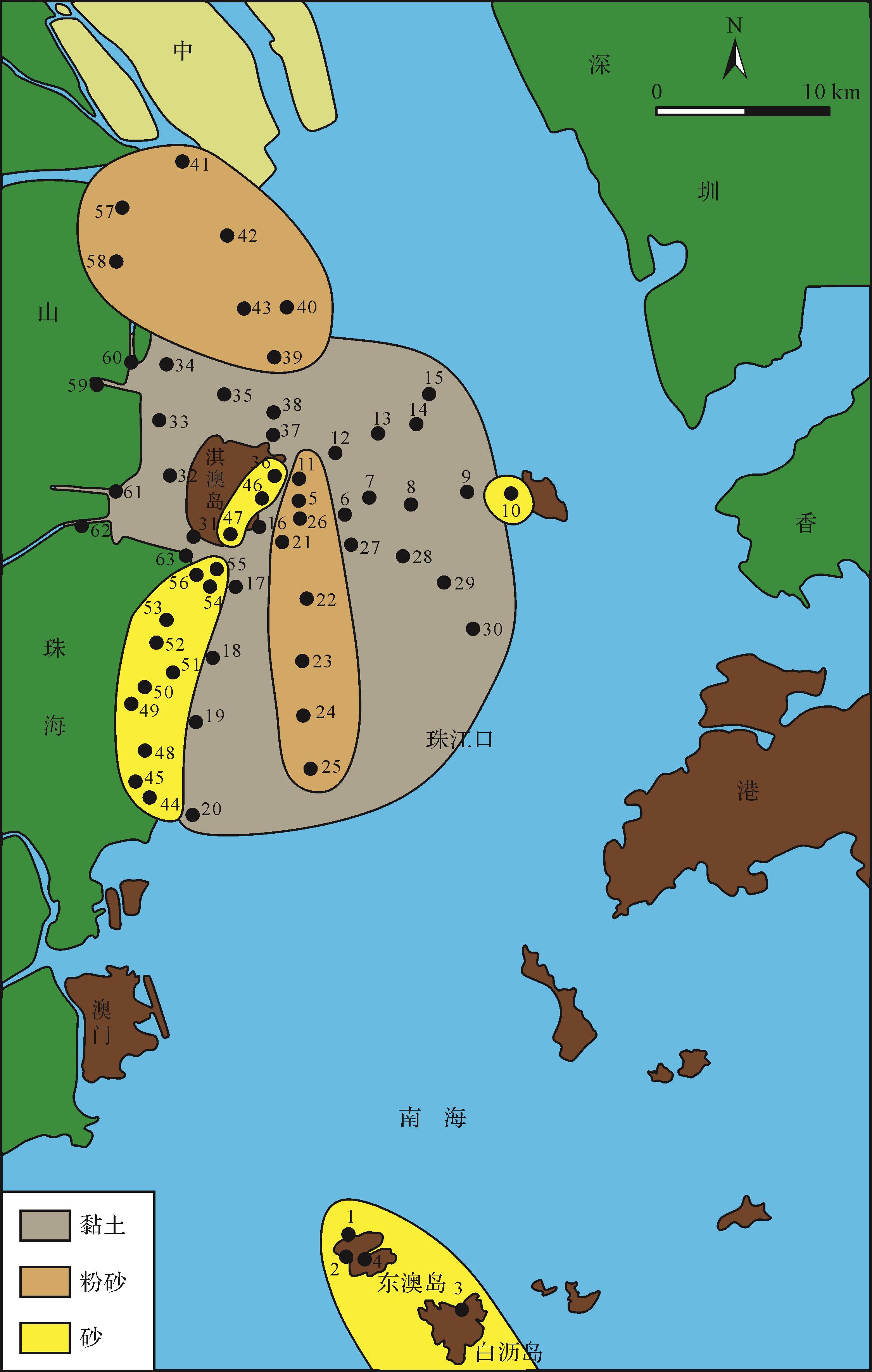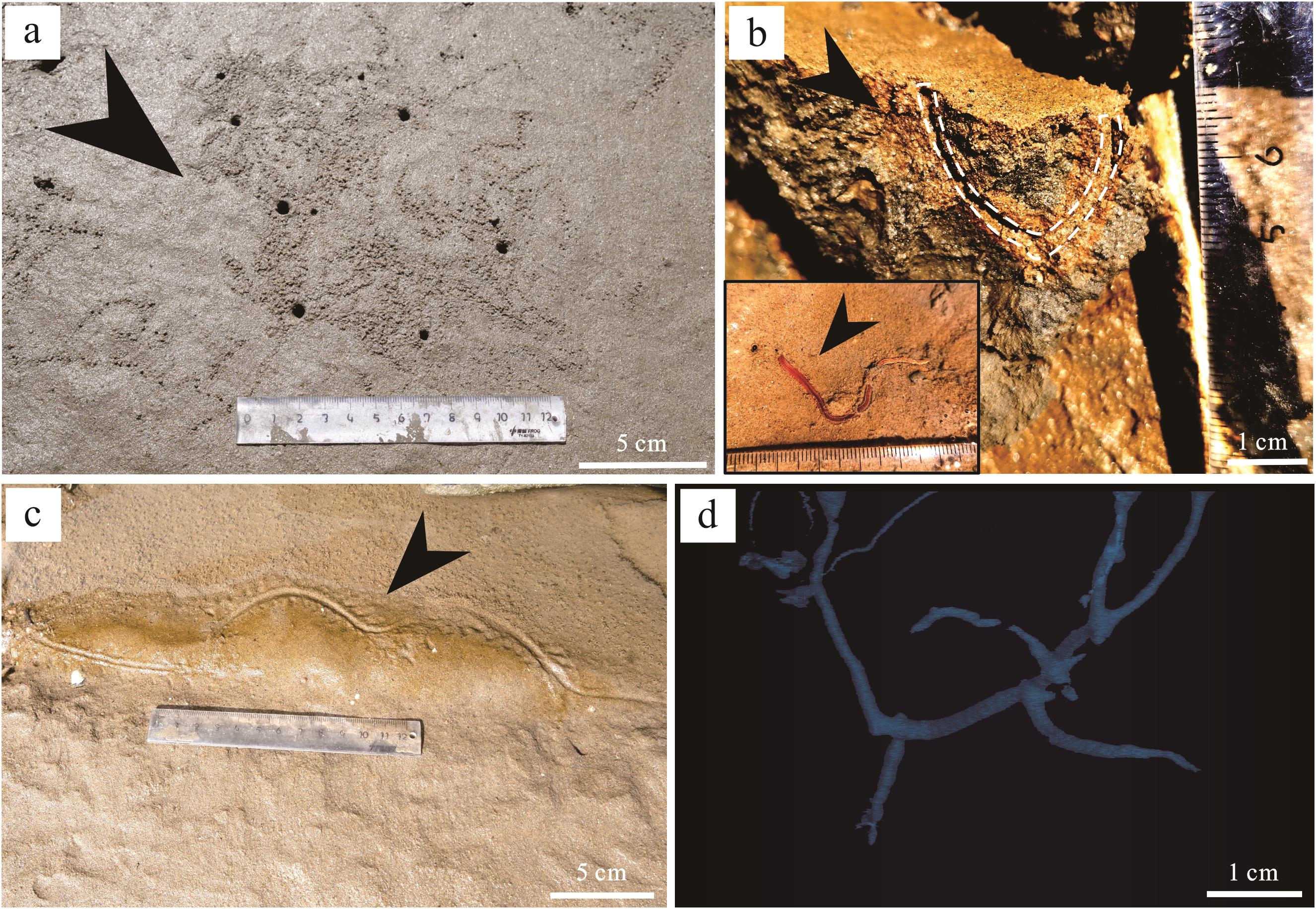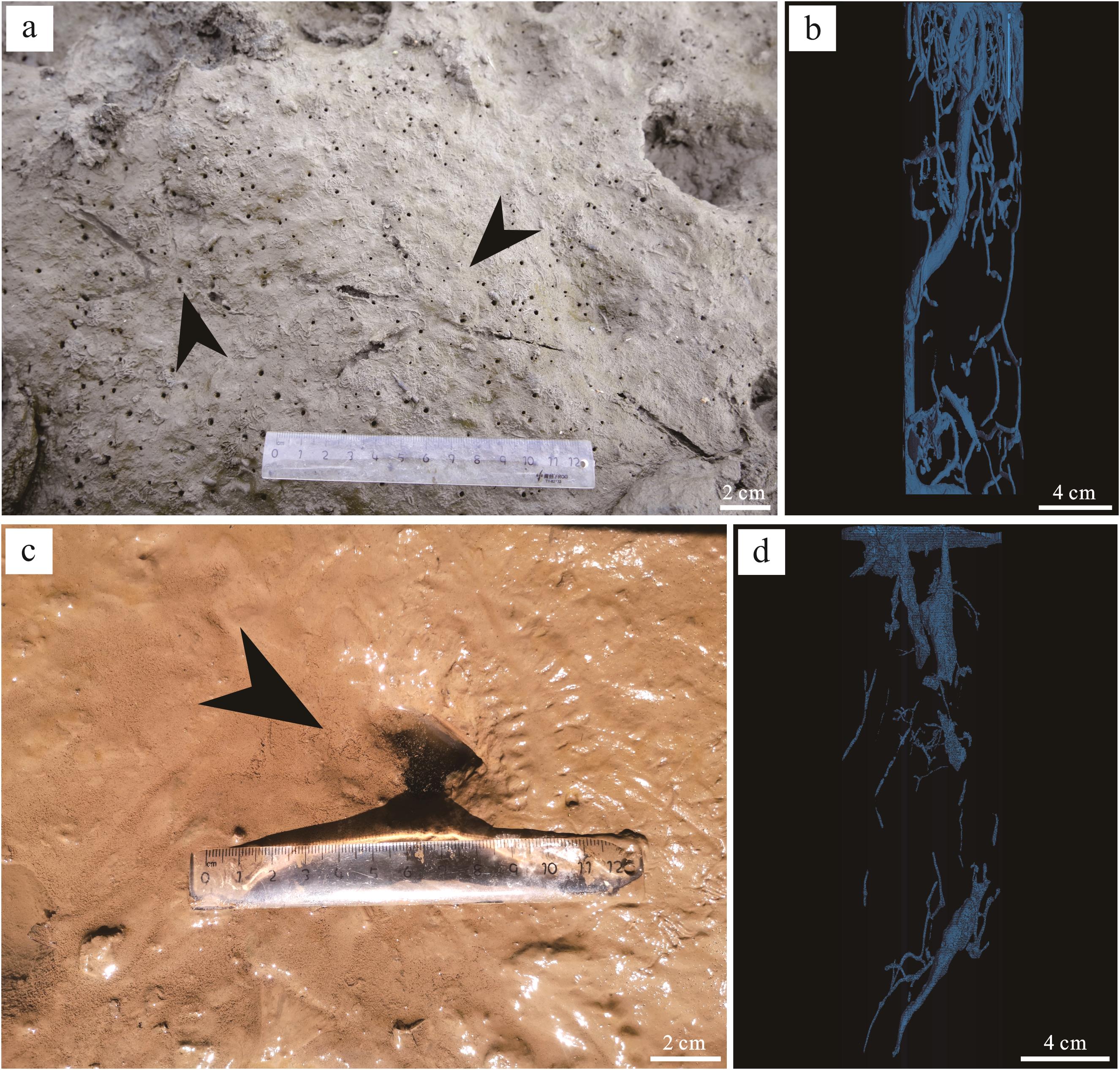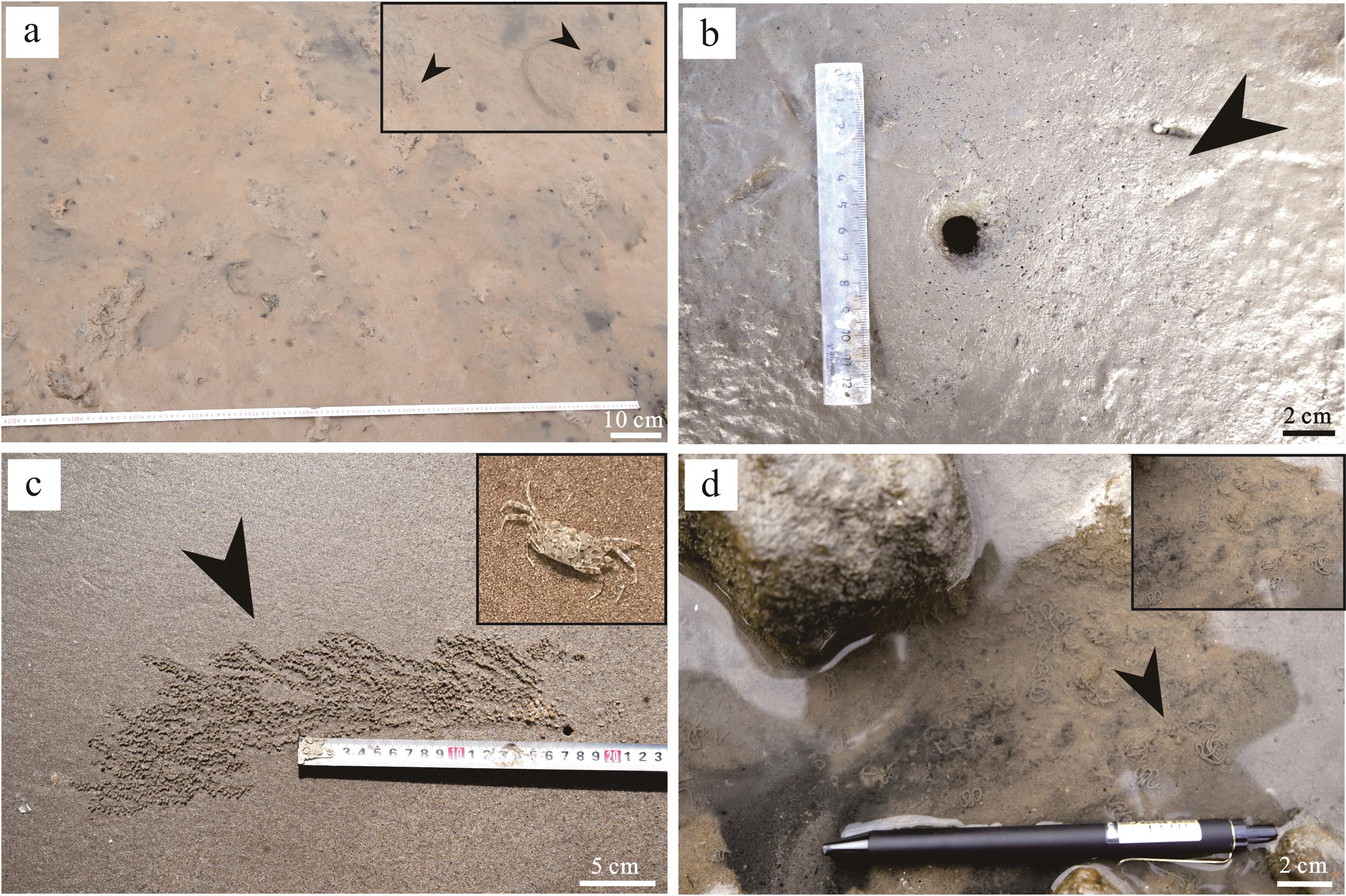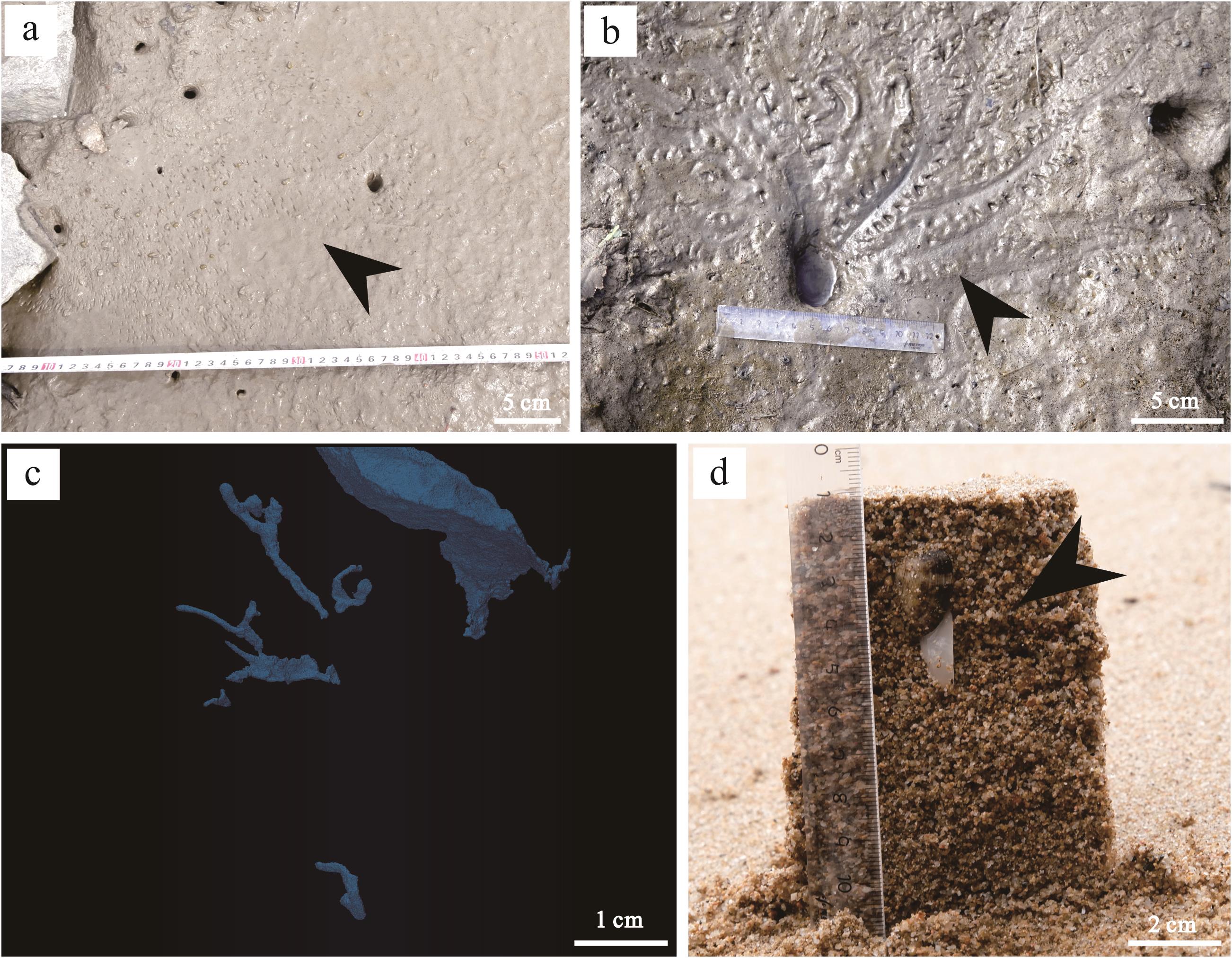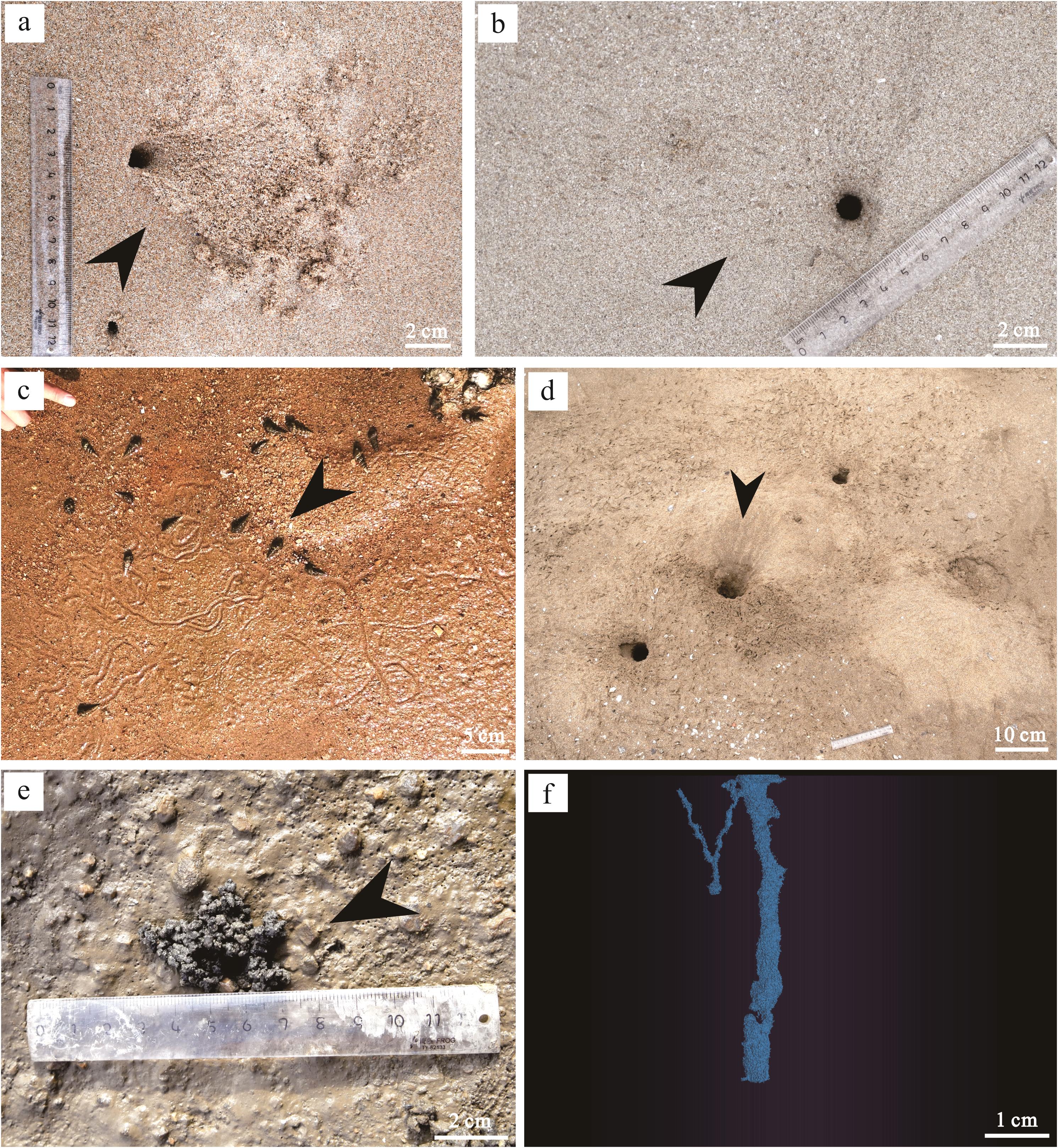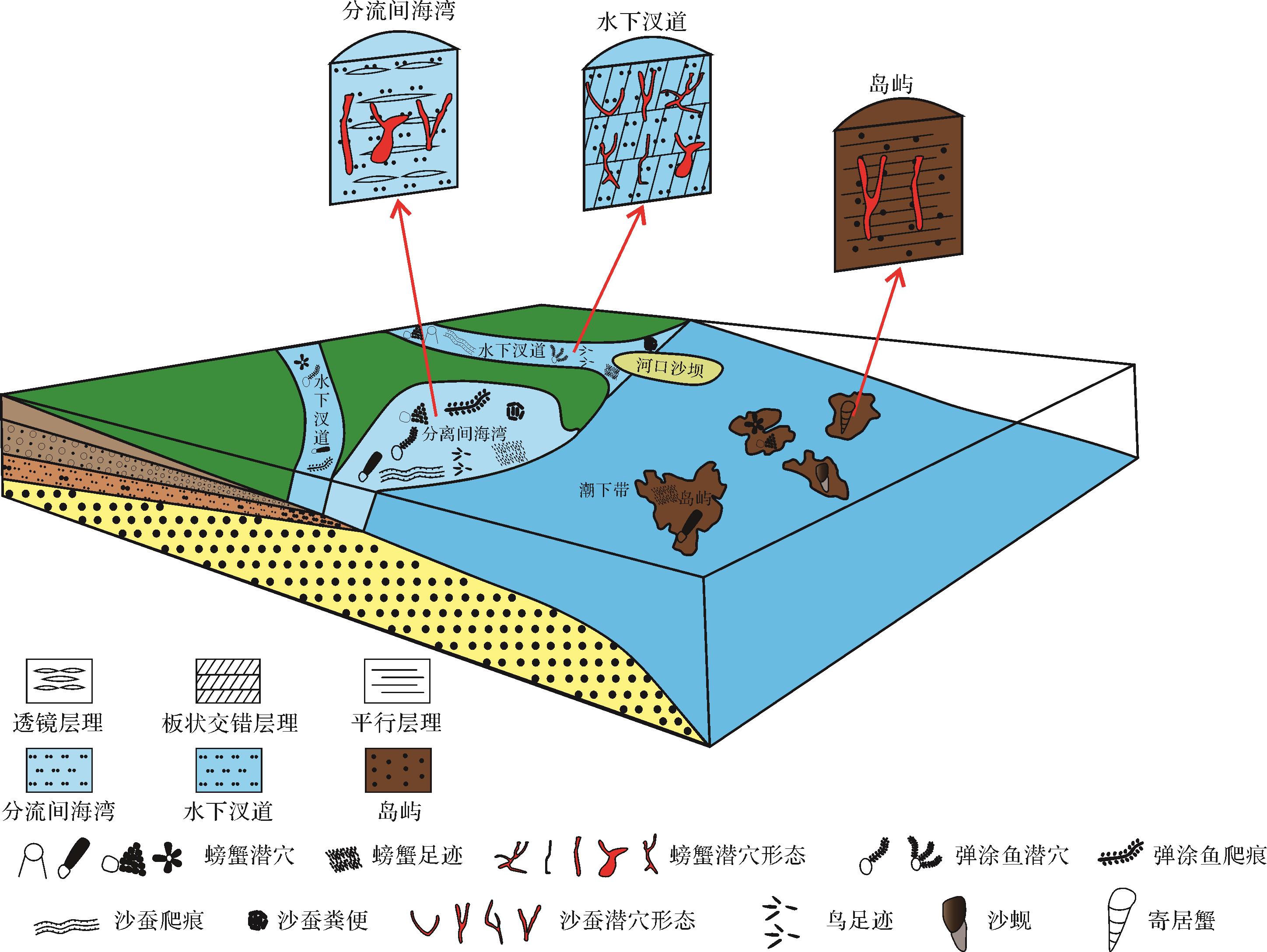HTML
-
三角洲沉积环境复杂,受到沉积学界的密切关注。前人对三角洲的研究主要集中于物理沉积环境,极少关注其中的生物成因的沉积构造。遗迹学研究的是现代和古代的生物遗迹,基于发现和分析生物成因的沉积构造,主要强调生物和环境的相互作用,为鉴定和解释沉积环境起到了不可替代的作用[1⁃8]。
近十年来,国外学者对三角洲的现代沉积学研究和现代生物遗迹研究主要集中于弗雷泽河三角洲[9⁃11]和尼罗河三角洲[12⁃13]等地;国内的研究多数集中于以下研究区:黄河三角洲潮坪现代沉积及生物遗迹特征[14⁃22]、沉积演变以及河流流量对水动力和沉积过程的影响[23⁃24]等;长江三角洲潮坪现代沉积特征、潮汐动力特征[25⁃27]等;杭州湾的现代沉积和现代生物遗迹特征[28];青岛日照潮坪现代沉积和现代生物遗迹特征[29];滦河三角洲现代造迹生物及其遗迹的组成和分布特征[30]。这些研究揭示了生物遗迹对三角洲亚环境、微环境的指示作用,为古三角洲遗迹学的发展提供了现实依据,同时也为油气勘探开发和成煤作用研究提供了指导和理论依据[19,31⁃36]。
现代珠江三角洲前缘在不同沉积微环境中具有河流、波浪、潮汐分别主控或者共存的现象,特征丰富。而前人对珠江三角洲的研究大都侧重于珠江三角洲的形成、发展和演变过程[37⁃40]、水文泥沙特征[41⁃42]、潮汐、沉积环境和沉积特征[43⁃46]等方面,尚未对珠江三角洲前缘现代生物遗迹的组成和分布特征进行系统研究。因此,开展现代珠江三角洲前缘沉积学及现代遗迹考察研究,将为研究珠江三角洲前缘现代沉积提供现代生物学实证基础,并为研究古三角洲前缘沉积特征和古遗迹学特征提供现代遗迹学依据。
-
研究区位于广东省珠江下游入海口,与香港、澳门相邻,周围岛屿众多(图1)。珠江水系是我国四大水系之一,有着三江(东江、西江和北江)汇流、八口(虎门、蕉门、洪奇门、横门、磨刀门、鸡鸣门、虎跳门和崖门)入海[39]的美誉,水流情况复杂。在我国四大水系中,珠江水系年平均径流量(3.456×108 m3)居第二位,年平均输沙量(0.283 kg/m3)和含沙量居第三位,珠江流域面积(约45.26×104 km2)及长度(2 320 km)居第四位[41,45]。
珠江三角洲是由东江、西江和北江等多条河流在珠江古河口湾内堆积而成的复合三角洲[47⁃49],各河口均为有潮汐河口。各河口潮汐属不规则半日潮,每月两涨两落,大潮汛、小潮汛各六天,其余为寻常潮,潮差一般为0.86~1.66 m,属弱潮[37,42,45]。研究区处于北回归线以南沿海地区,气温较高,降雨量充足,年平均气温为21.5 ℃~22.5 ℃,年平均降雨量在1 600 mm以上,但季节分配不均,多集中在雨季,使得径流和潮流变率大[45]。湾内岛屿残丘众多,形成口门屏障,故波浪作用微弱,平均波高1 m左右[42,45]。物源区风化作用强,使得搬运的沉积物颗粒偏细[45],每年进入南海并沉积、扩散于河口湾及附近海岸和陆架区域的细颗粒泥沙合计超过8 400×104 t[50]。
本次研究选取珠江三角洲前缘亚环境作为研究区,其中河口沙坝、水下汊道、潮下带和分流间海湾等微环境生物扰动明显,为主要研究区。潮下带和前缘斜坡生物遗迹观测难度较大,仅研究其现代沉积特征。
-
采样点位于广东省中山市和珠海市沿岸以及淇澳岛、东澳岛四周海域,通过GPS(全球定位系统)确定各个采样点位置,并在Google Earth Pro进行标记绘制地图,共确定63个采样点。以淇澳岛为中心向外分散8条路线,共确定37个采样点,并在淇澳岛和东澳岛海岸选取8个采样点。此外,在中山市和香洲区沿岸及分支河道中确定18个采样点(图2)。
在各个采样点采取水样和土样,测定水样的盐度和浑浊度,并对土样进行粒度分析。在研究区内各个海岸和分流河道的采样点中,使用PVC管对形态保存完好且具有代表性的生物潜穴进行取心,所使用的PVC管直径为5.0 cm和7.5 cm,高度为15.0 cm。
-
将使用PVC管取得的岩心带到中国科学院南京土壤研究所进行CT扫描实验。CT扫描仪器参数如下:型号是Nanotom S,电压是180 kV,功率是15 W,细节检测能力高达200 nm。
-
三维重构即对CT扫描获取的CT图像数据(体数据)进行三维可视化处理,包括体数据三维渲染。灰度值分割、定向数字虚拟切面、动画制作和图片的保存等。处理过程中使用到ImageJ和VG Studio Max 3.0两款软件。三维重构过程在中国科学院南京古生物地质研究所X射线断层扫描实验室完成。
具体处理方式如下:(1)将扫描获取的切片图导入至ImageJ,观察生物潜穴是否清晰可见,将效果好的孔隙通过ImageJ进行提取,效果不好的进行降位(图片位深度由16 bit降至8bit);(2)将在ImageJ中处理过的图片导入VG Studio 3.0再次处理,最后对制作完成的生物潜穴进行渲染和动画的制作,将图片和视频保存。
-
将采集的沉积物样品带回实验室,在105 ℃的烘箱内进行干燥。干燥后的沉积物按照不同的微环境装入样品袋,每袋样品50 g左右,采用Rise2008激光粒度分析仪进行粒度分析。样品通过仪器的分选,得到多个粒度曲线,通过软件PADMAS颗粒粒度测量分析系统(Particle Diameter Measure & Analysis System)将测试数据做平均、统计、比较和模式转换等处理,得到分析结果。
2.1. 取样
2.2. CT扫描
2.3. 三维重构
2.4. 粒度分析
-
珠江三角洲地区的河流在潮流、径流和其他海洋动力的影响下沉积作用较为强烈,西江径流作为沉积作用的主要动力,主要物质也为西江物质[49,51]。在上述因素和化学风化作用的共同影响下,沉积物构造以类块状构造和粉砂质黏粒结构为主[51]。层理是水流与沉积物共同作用产生的某种几何形态的沉积单位,在沉积构造研究中极其重要[46]。研究区内发现多种层理,如韵律层理(图3a)、泥沙互层的平行层理(图3b)等。除层理外,还发现在潮流和波浪作用下形成的波痕,如由不同方向潮流和波浪或两者共同作用形成的干涉波痕(图3c)、削顶波痕(图3d)等。
-
珠江三角洲属多源水系相汇,其径流和河口潮流在不同季节、不同口门、不同发展阶段表现不同[44],径流和河口潮流的相互消长使得沉积物组分不均,沉积环境复杂。研究区内采样点分布主要分布在分流间海湾、潮下带、水下汊道、潮汐水道和岛屿等微环境中(图4)。沉积物粒度分布曲线以粒度大小和百分含量为横纵坐标,是对环境进行解释非常有效的图解形式,各采样点多为粉砂,部分为中砂,分选性整体较差,水的盐度较高,多为咸水,部分为半咸水,淡水较少(表1)。

Figure 4. Division of microenvironment and distribution of biological traces in the Pearl River Delta front
微环境 站点 粒径/mm 描述 分选/σ 描述 盐度 描述 分流间海湾 17 18.10 咸水 18 0.006 极细粉砂 1.525 差 18.80 咸水 19 0.005 极细粉砂 1.473 差 18.20 咸水 20 0.005 极细粉砂 1.508 差 19.20 咸水 31 0.006 极细粉砂 1.603 差 16.20 咸水 32 0.006 极细粉砂 1.632 差 15.90 半咸水 33 0.007 极细粉砂 1.629 差 10.30 半咸水 34 0.007 极细粉砂 1.645 差 3.44 半咸水 35 0.007 极细粉砂 1.764 差 8.13 半咸水 44 0.463 中砂 0.488 好 16.80 咸水 45 0.307 中砂 0.635 较好 18.00 咸水 48 0.006 极细粉砂 1.629 差 5.48 半咸水 49 0.010 细粉砂 3.256 极差 50 0.365 中砂 0.566 较好 13.90 半咸水 51 0.311 中砂 0.690 较好 10.60 半咸水 52 0.250 细砂 0.701 中等 14.10 半咸水 53 13.60 半咸水 54 0.244 细砂 0.781 中等 14.20 半咸水 55 11.60 半咸水 56 0.023 中粉砂 2.258 极差 2.17 半咸水 61 0.006 极细粉砂 1.478 差 9.27 半咸水 62 0.010 细粉砂 1.830 差 2.20 半咸水 63 12.10 半咸水 潮下带 5 0.014 细粉砂 2.609 极差 11.80 半咸水 6 0.007 极细粉砂 1.818 差 20.90 咸水 7 0.008 极细粉砂 1.844 差 21.60 咸水 8 0.008 极细粉砂 1.967 差 23.50 咸水 11 0.009 细粉砂 2.057 极差 11.80 半咸水 12 0.007 极细粉砂 1.763 差 18.30 咸水 13 0.010 细粉砂 2.154 极差 20.40 咸水 14 0.007 极细粉砂 1.876 差 21.30 咸水 16 0.006 极细粉砂 1.565 差 17.40 咸水 21 0.008 细粉砂 1.981 差 18.60 咸水 22 0.011 细粉砂 2.317 极差 18.90 咸水 23 0.011 细粉砂 2.469 极差 20.70 咸水 24 0.093 极细砂 2.503 极差 22.00 咸水 25 0.012 细粉砂 2.188 极差 22.30 咸水 26 0.008 细粉砂 2.012 极差 20.20 咸水 27 0.007 极细粉砂 1.809 差 22.10 咸水 28 0.007 极细粉砂 1.836 差 25.00 咸水 29 0.030 中粉砂 2.975 极差 26.40 咸水 30 0.007 极细粉砂 1.790 差 26.50 咸水 37 0.007 极细粉砂 1.746 差 15.80 半咸水 38 0.007 极细粉砂 1.910 差 12.60 半咸水 39 0.018 中粉砂 2.589 极差 9.31 半咸水 40 0.019 中粉砂 2.384 极差 14.30 半咸水 43 6.23 半咸水 续表 in the Pearl River Delta front Table 1. Grain size and salinity parameters of sediment samples from different microenvironments
-
采样点包括站点17~20、31~35、44~45、48~56和站点61~63,该区域靠近海岸线分布。该区域沉积物粒度介于0.005~0.463 mm,以极细粉砂为主,各采样点分选普遍差(表1)。站点49的粒度分布曲线为尖锐双峰不对称型(图5a),分选较差(表1),水动力条件较弱,以潮汐作用为主的静水环境[46,52]。
-
站点5~8、11~14、16、21~30以及站点37~40和站点43的微环境为潮下带,潮下带处于平均海平面以下,沉积物粒度普遍较细,该区域采样点沉积物粒度介于0.005~0.093 mm,多为极细粉砂与细粉砂,分选极差(表1)。站点39的粒度分布曲线形态与站点49相同,为尖锐双峰不对称型(图5b),分选极差,水动力条件弱,潮流作用强于径流作用[45]。
-
站点41~42和站点57~60选取,主要受径流的影响,是潮涨潮落的通道,沉积物多为粗粉砂,粒度介于0.006~0.038 mm,分选性较差(表1)。站点60的粒度分布曲线为单峰不对称型(图5c),分选较差,水动力在径流和潮流的共同作用下较弱。自口门向外,径流作用在潮流作用的反作用下由强逐渐变弱[46]。
-
选取的采样点较少,仅有站点9和站点15。潮汐水道主要受潮流的影响,为涨潮落潮通道,分选极差。站点9的粒度分布曲线为双峰不对称型(图5d),仅受潮汐作用影响,水动力较弱。
-
采样点包括站点1~4、10、36和站点46~47,岛屿受潮流和近岸流作用的共同影响,粒度较大,多为中砂。站点47的粒度分布曲线为尖端单峰近对称型(图5e),水动力较强,分选较好。
通过比较各个微环境的沉积物粒度发现,从分流间海湾和潮下带等微环境到离岸较远的岛屿微环境,沉积物粒度逐渐增大,这表明水动力也逐渐增强,不同微环境的粒度分析比较如图5f,研究区内采样点依据粒度划分如图6。
3.1. 物理沉积构造特征
3.2. 沉积物粒度特征
3.2.1. 分流间海湾
3.2.2. 潮下带
3.2.3. 水下汊道
3.2.4. 潮汐水道
3.2.5. 岛屿
-
研究区内主要的造迹生物主要有沙蚬(Mactridae)、螃蟹(Brachyura)、双齿围沙蚕(Perinereis)和弹涂鱼(Periophthalmus),部分采样点存在寄居蟹(Paguridae)、贻贝(Mytilus)、疣荔枝螺(Reishia)和芝麻螺(Planaxidae)以及鸟类等生物痕迹,具体造迹生物遗迹分布情况如下。
-
站点57:该点主要的造迹生物为螃蟹,生物扰动明显,还发现有沙蚕和弹涂鱼,但数量较少。螃蟹在层面上留下的痕迹有居住迹、足辙迹和排泄迹,潜穴口为近圆形,潜穴口四周有沉积物堆积,可能是建造潜穴时挖出(图7a)。双齿围沙蚕的造迹主要为爬行迹和居住迹,竖直剖开沉积物,可以看到长1.3 cm的U型沙蚕潜穴,潜穴内壁光滑,有铁锈色,可能是沙蚕分泌的黏液附着(图7b)。该站点的沉积物粒度为中粉砂,含水量适中,因此层面上的弹涂鱼遗迹清晰,但未观察到弹涂鱼的潜穴,主要为爬行、跳跃痕迹(图7c),中间为一条宽2~5 mm的拖迹,两侧明显的纹理为胸鳍的压痕。三维重构结果显示,表层有明显的四个孔隙,三大一小。三维重构为复杂的Y型分支潜穴,上部有一条沙蚕的遗迹潜穴,没有共生现象(图7d)。另一个只在上部有倾斜的L型潜穴,中部出现双壳的壳体。

Figure 7. Characteristics of traces of crabs, nereis and mudskippers in the underwater branch of the Pearl River Delta front
站点58:该点的主要造迹生物有螃蟹和沙蚕,产生的生物遗迹有螃蟹居住迹和双齿围沙蚕的居住迹和排泄迹,还发现有鸟足迹(图8a)。采集的2个PVC样品经扫描重构后,螃蟹、沙蚕潜穴清晰(图8b),生物扰动明显。螃蟹潜穴形态大多较粗,多呈L型、Y型和U型,部分有瘤状凸起。沙蚕潜穴形态较细,多呈I型,部分微倾斜。

Figure 8. Characteristics of surface⁃level biological traces and intra⁃layer burrows in the underwater branch of the Pearl River Delta front
站点59:该点的造迹生物为螃蟹和弹涂鱼。弹涂鱼多生活在靠近潮道的饱和水沉积物中,主要的生物遗迹为弹涂鱼的居住迹和爬行迹(图8c)。当弹涂鱼受到外界惊吓时会迅速返回潜穴,故其潜穴多为倾斜的逃逸潜穴。螃蟹潜穴集中在含水量小的靠岸侧,生物遗迹主要为居住迹和足辙迹。PVC样品扫描重构结果显示样品顶部和中部有较粗的倾斜潜穴,还分布着部分细小的Y型和I型潜穴,且与粗枝相连(图8d)。
站点60:该点的主要造迹生物是沙蚕和弹涂鱼,生物扰动明显,螃蟹数量较少,产生的生物遗迹有沙蚕居住迹、弹涂鱼居住迹和弹涂鱼运动迹以及螃蟹居住迹。重构结果显示沙蚕潜穴较细,形态多呈Y型、U型和I型,螃蟹潜穴较粗,形态呈L型。
-
站点45:该点沉积物为沙泥互层,螃蟹是主要造迹生物,集中出现在浅滩的淤泥中,淤泥下石块较多,无法使用PVC进行采取。螃蟹潜穴数量多而密集,但泥质疏松,足辙迹不明显(图9a)。除螃蟹外,还有少量沙蚕、弹涂鱼生活的痕迹和鸟足迹。
站点48:层面上的生物遗迹有螃蟹居住迹、足辙迹和鸟足迹,螃蟹足辙迹呈点坑状分布在潜穴一侧,潜穴口为烟囱状,高于沉积物表面(图9b),周围有植物生长。三维重构结果显示有4.7 cm高的Y型螃蟹潜穴位于PVC管上部。
站点54:该点的造迹生物仅观察到螃蟹,其遗迹主要为居住迹和团状的排泄迹,排泄迹呈尾状分布(图9c)。
站点56:该点的造迹生物主要有沙蚕、螃蟹和弹涂鱼,还发现有鸟足迹。沙蚕居住迹和排泄迹(图9d)以及螃蟹居住迹较多,生物扰动明显,弹涂鱼和鸟足迹等遗迹较少。沙蚕居住迹内部主要分布在上部,中下部较少,形态呈I型、Y型和复杂分支型。

Figure 9. The characteristics of dwelling traces, trackways and excretion traces in the interdistributary bays of the Pearl River Delta front
站点61:弹涂鱼和螃蟹该点的造迹生物,生物扰动明显。层面上的主要生物遗迹为两者的居住迹、螃蟹点坑状的足辙迹和弹涂鱼的爬行迹(图10a)。
站点62:该点的造迹生物为螃蟹、双齿围沙蚕和弹涂鱼,生物扰动明显。螃蟹和沙蚕大多分布在远离潮道的靠岸侧,沉积物含水量少,较坚固,有植被分布,主要遗迹为螃蟹居住迹、沙蚕居住迹。弹涂鱼分布在靠近潮道的位置,主要遗迹为觅食迹、居住迹和足辙迹(图10b),痕迹大多模糊不清,其觅食迹基本沿饱和水的一侧呈放射状向外散开,潜穴口大多呈圆形或向一侧倾斜椭圆形,后一种的潜穴口大多只有一条逃逸迹。共采集3个PVC样品,扫描重构结果较好。1号样品判断为螃蟹潜穴,重构结果显示形态呈复杂的分支型,分支连接处多为瘤状凸起,应是螃蟹休息、转身造成。2号样品顶部有一条直径为1 cm的倾斜的螃蟹潜穴,中上部也有Y型倾斜潜穴(图10c)。3号有一条直达底部的Y型螃蟹潜穴,周围还有着复杂的分支型沙蚕潜穴,这些生物潜穴相连,螃蟹和沙蚕可能为共生。
-
站点1:共采取3个PVC样品,但扫描结果均不理想,未发现生物营造的潜穴形态。该点层面上出现的主要造迹生物为沙蚬,其主要生活在淡、咸水交汇处,碎石堆下的泥沙中数量较多,偶见在沙滩营造潜穴。沙蚬常生活在沙土下,使用PVC管取岩心观察沙蚬下潜过程及潜穴形态(图10d)。除沙蚬潜穴外,还发现不少螃蟹潜穴(图11a)。此外还出现贻贝(青口)、芝麻螺、水蚯蚓、海蛞蝓、疣荔枝螺和鸟足迹,但数量较少。
站点2:该点发现的造迹生物只有螃蟹,层面上可观察到足辙迹和潜穴(图11b)。采取1个PVC样品,扫描结果显示上部有较多小的孔隙,中上部粒度变大、无空隙,下部粒度最细。
站点3:该点发现的造迹生物只有沙蚬,其数量较多。营造有沙蚬潜穴,但由于潮水冲刷,无法采取PVC样品。
站点4:该点处于嵌入东澳岛中部的湾内,水动力较弱,长时间处在水平面以上,主要的造迹生物是寄居蟹,未发现其潜穴,运动产生的拖痕较多、较明显(图11c)。除寄居蟹外,岩缝中栖息着螃蟹,还发现有生蚝。
站点10:该点人迹罕至,生物遗迹保存完好,生物扰动明显。层面上发现的生物遗迹有螃蟹潜穴和点坑状的足辙迹,潜穴洞口大、数量多,足辙迹密集、明显(图11d)。
站点46:层面上观察到的造迹生物只有螃蟹,螃蟹潜穴较多且多数潜穴旁都有团状的排泄迹(图11e)。PVC重构结果显示沉积物的粒度结构为上粗下细的沙泥互层,还发现了I型螃蟹潜穴和Y型沙蚕潜穴(图11f)。
4.1. 水下汊道生物遗迹
4.2. 分流间海湾生物遗迹
4.3. 岛屿生物遗迹
-
三角洲前缘分流间湾微相主要分布的遗迹化石包括Planolites、Palaeophycus、Thalassinoides、Teichi chnus、Ophiomorpha、Skolithos、Diplocraterion、Rosselia等。三角洲前缘水下分流河道微相主要分布的遗迹化石包括Ophiomorpha、Macaronichnus、Chondrites、Arenicolites等。三角洲前缘河口沙坝微相主要分布的遗迹化石包括Palaeophycus、Chondrites、Helminthop sis、Arenicolites、Planolites、Asterosoma、Macaronichnus、Scolicia等。三角洲前缘水下汊道微相主要分布的遗迹化石包括Teichichnus、Thalassinoides、Arenicolites、Planolites、Skolithos、Treptichnus、Diplocraterion、Rosselia等。这些遗迹化石,有层面分布的水平遗迹也有垂直层面分布的Y形、U形、L形等潜穴系统,造迹生物大多与蠕虫类如沙蚕和甲壳类如螃蟹等有关(表2)。珠江三角洲前缘所研究的现代生物遗迹层面层内分布形态多样,现代造迹生物也主要是蠕虫类沙蚕、甲壳类的螃蟹及双壳类生物(图12),因此现代珠江三角洲前缘的现代生物遗迹具有较强的保存潜力,也进一步明确了上述遗迹化石可能的造迹生物。
-
古三角洲前缘在不同的沉积微相中存在多种遗迹相如Teredolites遗迹相、Glossifungites遗迹相、Skolithos遗迹相、Cruziana遗迹相、Psilonichnus遗迹相、Zoophycus遗迹相以及mixed Skolithos⁃Cruziana遗迹相(表2),以砂为主的相丰度更高[60],因此现代珠江三角洲前缘不能简单地用任何一类已建立的遗迹相来描述。珠江三角洲前缘环境的生物遗迹既有层面类型又有层内类型,混合了典型的Skolithos遗迹相、Cruziana遗迹相以及Psilonichnus遗迹相。因此,适用于复杂综合应力条件下珠江三角洲前缘的类古三角洲前缘的遗迹相模型有待建立。
-
沉积速率影响着遗迹的分布,沉积速率高导致大规模重力破坏使得遗迹多样性较低[63⁃64],珠江三角洲前缘现代生物遗迹为类比研究古三角洲前缘沉积速率提供了现代遗迹方面的实证材料。低沉积速率下有利于造迹生物在沉积底层造迹以及生物遗迹的更均衡分布和保存,而高沉积速率条件下底层沉积物间歇性瞬时性的迅速沉积导致生物生殖、居住活动锐减,生物遗迹丰度随之降低。另外,随着沉积物的迁移和瞬时沉积,动荡和不稳定的环境限制了造迹生物的种类,从而导致生物遗迹分异度降低。
表2 古三角洲前缘遗迹学特征
Table 2 The ichnological characters of the palaeo⁃delta front
三角洲前缘微环境 遗迹化石 遗迹化石基本特征 造迹生物 营养类型 遗迹相 地质年代 环境的影响因素 参考文献 分流间湾 Planolites 水平或近水平的或微倾斜的主动充填的简单结构遗迹 蠕虫类 食碎屑沉积物 Teredolitesichnofacies,Glossifungitesichnofacies,Psilonichnusichnofacies Neogene,Permian,Early Devonian 受潮汐影响的半咸水环境,如潮坪或决口扇沉积环境 Buatois et al.[53]; Netto et al.[54] Palaeophycus 被动充填的光滑外壁的无衬壁的圆管状潜穴 蠕虫类,如沙蚕等环节、多毛类动物 食碎屑物、沉积物 Thalassinoides 有分支的水平或者垂直的无衬壁或者有薄衬壁的潜穴 甲壳类 食碎屑物 Teichichnus 水平或近倾斜的无衬壁的具有向后的璞状构造的潜穴 沙蚕、蠕虫、星虫动物、节肢动物 食沉积物 Ophiomorpha 水平到垂直的具有瘤状外壁的分支潜穴 甲壳类动物 食碎屑物 Skolithos 具有薄衬壁的不分支的垂直潜穴 蠕虫生物,如帚虫、多毛类生物 食悬浮物 Diplocraterion 垂直U形管状潜穴,具有向前的璞状构造 多毛类、海胆、端足目或者其他甲壳类生物 沉积物或有机碎屑 Rosselia 漏斗或纺锤形的垂直于地层的潜穴 多毛类、沙蚕 食沉积物或有机碎屑 Planolites 水平或近水平的或微倾斜的主动充填的简单结构遗迹 蠕虫类 食碎屑沉积物 分流河道 Ophiomorpha 水平到垂直的具有瘤状外壁的分支潜穴 甲壳类动物 食碎屑物 Cruziana ichnofacies,Skolithos ichnofacies Late Miocene,Paleocene 受潮汐影响的河控三角洲 MacEachern et al.[55]; Miguez-Salas et al.[56]; Quaye et al.[57];de Jesus Gomes de Sousa M et al.[58] Macaronichnus 层内觅食潜穴,柱状或亚柱状,不分支 多毛类 食沉积物 Chondrites 具有树枝形网状分支的潜穴系统 多毛类、星虫类生物 食碎屑物 Arenicolites 无分支的垂直于层面的U形潜穴 多毛类 食碎屑物 河口沙坝 Palaeophycus 被动充填的光滑外壁的无衬壁的圆管状潜穴 蠕虫类,如沙蚕等环节动物、多毛类动物 食碎屑物、沉积物 Cruzianaichnofacies,Zoophycusichnofacies, Late Triassic 受潮汐影响的河控三角洲 MacEachern et al.[55] Chondrites 具有树枝形网状分支的潜穴系统 多毛类、星虫类生物 食碎屑物 Arenicolites 无分支的垂直于层面的U形潜穴 多毛类 食碎屑物 Planolites 水平或近水平的或微倾斜的主动充填的简单结构遗迹 蠕虫类 食碎屑沉积物 Asterosoma 水平分布的具有横条状纹理的分支遗迹 蠕虫类,如沙蚕 食沉积物 Macaronichnus 层内觅食潜穴,柱状或亚柱状,不分枝 多毛类 食沉积物 Scolicia 具有两条平行的拖迹,且中间有半月板的水平于层面分布的遗迹 棘皮动物 食沉积物 水下汊道 Teichichnus 水平或近倾斜的无衬壁的具有向后的璞状构造的潜穴 沙蚕、蠕虫、星虫动物、节肢动物 食沉积物 mixed Skolithos⁃Cruzianaichnofacies Miocene to Pliocene, Devonian 潮汐影响的三角洲前缘海岸沉积 Melchor [59]; O’Connell et al.[60]; Hofmann et al.[61]; Bradshaw[62] Thalassinoides 有分支的水平或者垂直的无衬壁或者有薄衬壁的潜穴 甲壳类 食碎屑物 Arenicolites 无分支的垂直于层面的U形潜穴 多毛类 食碎屑物 Planolites 水平或近水平的或微倾斜的主动充填的简单结构遗迹 蠕虫类 食碎屑沉积物 Skolithos 具有薄衬壁的不分支的垂直潜穴 蠕虫生物,如帚虫、多毛类生物 食悬浮物 Treptichnus 末端具有分支的平行于层面分布的潜穴 蠕虫类 食沉积物 Diplocraterion 垂直U形管状潜穴,具有向前的璞状构造 多毛类、海胆、端足目或其他甲壳类生物 沉积物或有机碎屑 Rosselia 漏斗或纺锤形的垂直于地层的潜穴 多毛类、沙蚕 食沉积物或有机碎屑 续表
5.1. 三角洲前缘遗迹化石
5.2. 三角洲前缘遗迹相
5.3. 古三角洲沉积环境
-
(1) 研究区内现代生物遗迹在水下汊道和岛屿的分布分异度和丰度较其他微环境高,搜集的生物遗迹信息可分为层上遗迹(拖迹、足辙迹、爬行迹和排泄迹等)和层内遗迹(居住迹)。
(2) 水下汊道和岛屿生物扰动明显,观察到的主要造迹生物有双壳类动物沙蚬Mactridae、节肢动物门寄居蟹Paguridae、甲壳类动物螃蟹Brachyura、环节动物门双齿围沙蚕Perinereis、脊索动物门弹涂鱼Periophthalmus以及鸟等,还有少量贻贝Mytilus、疣荔枝螺Reishia等。
(3) 分流间海湾生物扰动较水下汊道和岛屿弱,主要造迹生物为甲壳类动物螃蟹Brachyura。潮下带位于平均低潮线以下,不便观察,未发现明显生物遗迹。各微环境生物在层面上营造的生物遗迹主要包括爬行迹、足辙迹、鸟足迹以及排泄迹等,层内的主要遗迹为居住迹,表现为各种类型的潜穴形态。

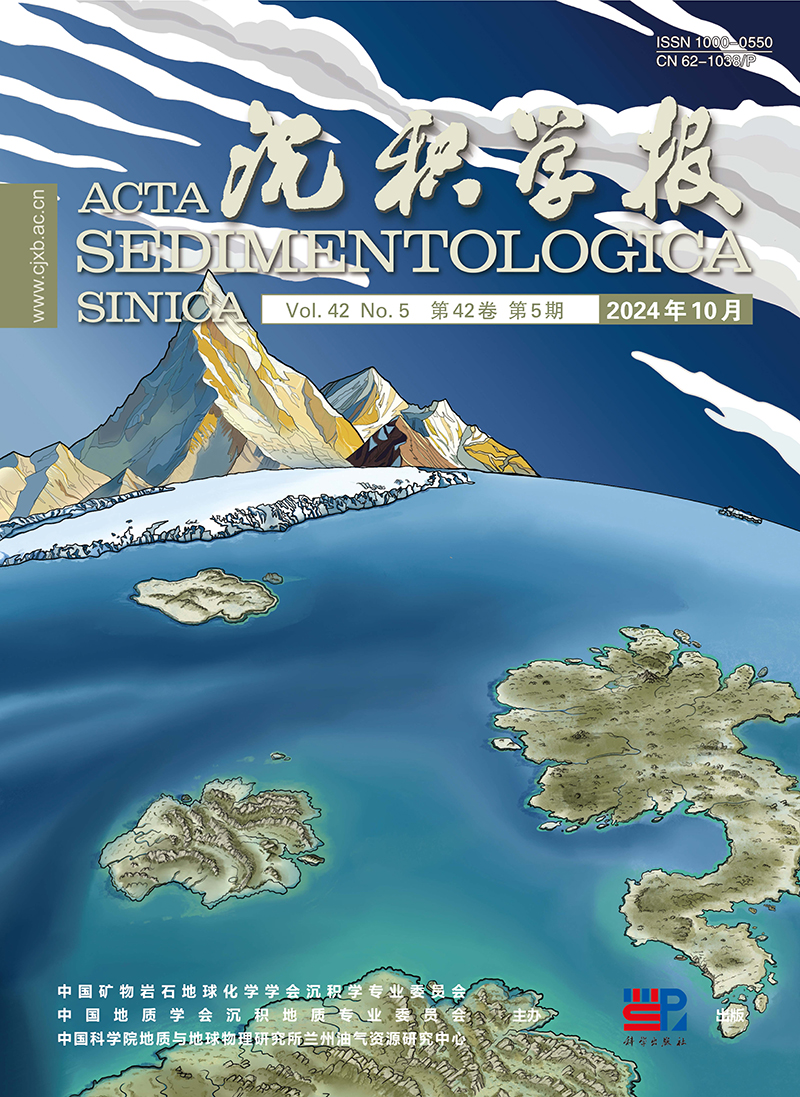


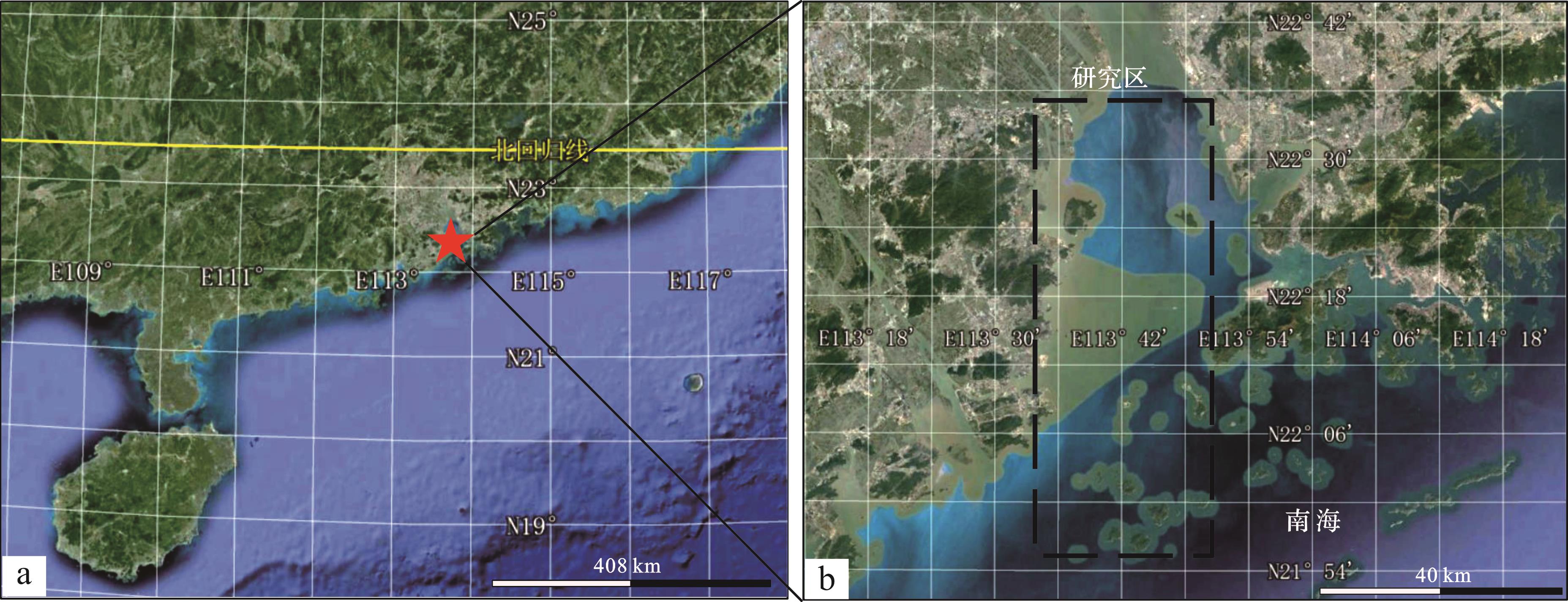










 DownLoad:
DownLoad:

